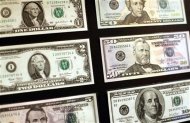
LONDON (Reuters) - The dollar briefly fell to a two-month low against a basket of currencies on Monday, hurt by signs that the U.S. economic recovery was losing momentum, which keeps alive the chances of further monetary easing by the Federal Reserve.
Despite the dollar's problems, the euro failed to gain much traction, with investors looking to sell at higher levels as harsh austerity measures take a toll on economic activity across the region.
Spain slipped back into recession as gross domestic product shrank 0.3 percent in the January to March quarter, data showed on Monday. Traders were likely to be wary of the euro ahead of the second round of the French presidential vote as well as elections for a new Greek parliament next weekend.
The dollar (.DXY) touched 78.638 against a basket of currencies, its lowest since March 1, before rising to 78.855, up 0.2 percent on the day.
But the euro fell 0.3 percent against the dollar to $1.3215, off a near one-month high of $1.32706 on Friday, with near term support at its 55-day moving average of about $1.3206.
"The dollar is under pressure but the euro is by no means out of the woods and the Spanish GDP data is a pointer," said Peter Kinsella, currency strategist at Commerzbank, London.
"Besides, liquidity in the markets is a bit thin because of holidays this week and this can make price movements a bit exaggerated."
Markets in most of Europe will be shut on Tuesday for the May Day holiday, while Japan celebrates Golden Week holidays, keeping trading on foreign exchange markets a bit subdued.
Euro zone business confidence weakened sharply in April, and the European Central Bank could scale back its economic outlook at its policy meeting on Thursday. As such, the rising chances of more easing by the ECB in coming months could cap any gains in the euro against the dollar.
For now though, the ECB has little room to cut rates given inflation pressures are still above expectations.
The common currency fell to a two-week low against the yen of 106 yen. Investors expect the yen to benefit from safe-haven demand in view of Europe's debt problems.
The dollar dropped to 80.08 yen at one point on trading platform EBS, its lowest level since late February, and last stood at 80.15 yen, down 0.1 percent from late U.S. trade on Friday.
The dollar is likely to come under more pressure if data, including U.S. jobs numbers, this week disappoints. U.S. growth cooled in the first quarter partly due to businesses cutting back on investments, reinforcing the central bank's contention that interest rates should be kept near zero through 2014.
EYES ON U.S. DATA
The U.S. slowdown fuelled speculation that the Fed may eventually launch another bond buying program, or a third round of quantitative easing. That would likely have a negative effect on the dollar while giving riskier assets like stocks, commodities and higher-yielding currencies like the Australian dollar a boost.
Rob Ryan, a Singapore-based FX strategist for BNP Paribas, said the dollar could stay soft if the Institute of Supply Management data was on the softer side and payrolls disappointed by rising by 125,000. BNP Paribas economists are predicting an additional 125,000 U.S. jobs in April.
Average market expectations are for a rise of 170,000.
Any disappointment could see the dollar lose more ground, especially against the yen as speculators cut hefty bullish dollar positions. (IMM/FX)
"For dollar/yen, the key will be the Fed and U.S. rates. Until the Fed signals that they are growing more confident about a durable recovery is in place, it will be very tough for the dollar to sustain a rally," said Ned Rumpeltin, G-10 currency strategist at Standard Chartered.
"We have already seen huge swings both in prices terms and positioning so we are now cautious about the pair and see it trading in a 79-85 range for the next several weeks."
Market players said the dollar may fall further against the yen given a drop in U.S. Treasury yields. The dollar/yen exchange rate has a tight relationship with the spreads between yields on U.S. Treasuries and Japanese government bonds.
Other factors that suggest the dollar may stay under pressure against the yen include the existence of sizeable bearish positions in the yen, a lack of interest in foreign bond investment among Japanese investors, and the low probability of yen-selling intervention, traders said.
0 comments:
Post a Comment